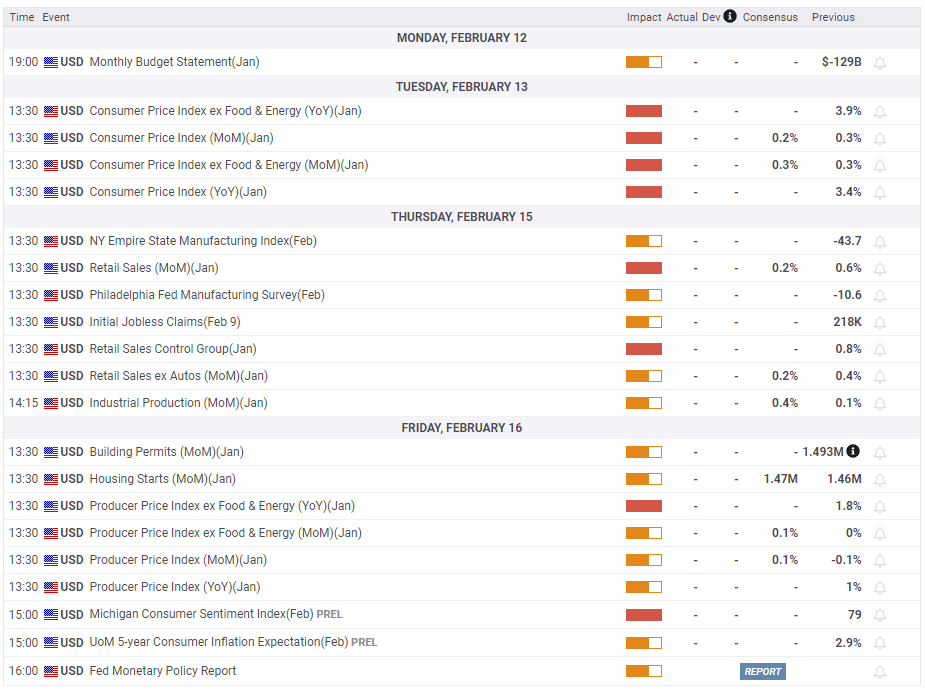- Gold failed to make a decisive move in either direction.
- $2,020 aligns as first near-term technical support for XAU/USD.
- January inflation data will be featured in the US economic docket next week.
Gold struggled to gather directional momentum and closed the week with marginal losses. Investors will scrutinize the January inflation data from the US next week and pay close attention to technical developments for a directional clue.
Gold price fluctuated in a relatively narrow channel this week
In a televised interview with CBS News’s 60 Minutes on Sunday, Federal Reserve (Fed) Chairman Powell repeated that the March policy meeting was likely too soon to have the confidence to start cutting rates. He also reiterated that they could move sooner if they saw labor market weakness or inflation coming down persuasively. The benchmark 10-year US Treasury Note yield extended the rally that was fuelled by the impressive jobs report and rose more than 3% on Monday, causing Gold to end the day in negative territory near $2,020.
In the absence of high-tier macroeconomic data releases and fundamental drivers, the US Dollar Index corrected lower alongside the US yields, allowing XAU/USD to stage a modest rebound.
Meanwhile, Qatar, acting as a mediator, said that Hamas had given a "generally positive" response to a proposed truce deal with Israel late Tuesday. This headline, however, failed to ease concerns over a deepening crisis in the Middle East, as an Israeli official told Israel's Channel 13 that some of the demands made by Hamas in the counterproposal were entirely unacceptable.
On Wednesday, risk flows started to dominate the action in financial markets as the S&P 500 Index hit a new record high after the opening bell. Although the improving risk mood made it difficult for the USD to find demand, XAU/USD failed to gather bullish momentum. Later in the American session, the 10-year US T-bond yield climbed above 4.1% after the high-yield at the latest 10-year Treasury Note auction came in at 4.09%, forcing Gold to erase earlier gains.
The US Department of Labor reported on Thursday that there were 218,000 Initial Jobless Claims in the week ending February 3, down from the previous week's revised 227,000. The USD held resilient against its rivals and Gold struggled to regain its traction. In the meantime, Richmond Fed President Thomas Barkin told Bloomberg that they have time to be patient on rate changes and said that he needs to see good inflation numbers being sustained and broadening.
On Friday, the US Bureau of Labor Statistics (BLS) announced that it revised the monthly Consumer Price Index (CPI) increase for December lower to 0.2% from 0.3%. The Core CPI was unrevised at 0.3% for the same period. Gold edged slightly lower in the American session as the 10-year US yield continued to stretch higher ahead of the weekend.
Gold price could react to US inflation data, technical developments
The BLS will release January inflation data on Tuesday. On a monthly basis, the CPI and the core CPI, which excludes volatile food and energy prices, are forecast to rise 0.2% and 0.3%, respectively. It will take a significant downward surprise in monthly CPI readings, at or below 0%, for market participants to reconsider the probability of a Fed rate cut in March. In this scenario, the 10-year US T-bond yield could retreat below 4% and help XAU/USD gather bullish momentum.
According to the CME FedWatch Tool, the odds of the US central bank maintaining the policy rate unchanged at the next policy meeting is 82.5%. The market positioning suggests that the USD doesn’t have a lot of room left on the upside in case CPI prints come in above market forecasts. Nevertheless, a hot inflation report could support US yields and make it difficult for Gold to gain traction.
On Thursday, the Retail Sales report for January will be featured in the US economic docket. This data is not adjusted for price changes and it’s unlikely to trigger a significant market reaction.
Ahead of the weekend, the Producer Price Index (PPI) data for January and the University of Michigan’s preliminary Consumer Sentiment Index data for February will be watched by market participants.
In summary, unless the US inflation report meaningfully alters the market pricing of the Fed rate outlook, investors are unlikely to take large positions based on next week’s data releases. Instead, they might keep a close eye on technical developments for near-term trading opportunities.
Gold technical outlook
The Relative Strength Index (RSI) indicator on the daily chart moves sideways near 50 and XAU/USD struggles to pull away from the 20-day Simple Moving Average (SMA), reflecting the lack of directional momentum.
On the downside, $2,020 (Fibonacci 23.6% retracement of the latest uptrend) aligns as first support before $2,000 (psychological level, static level) and $1,990 (100-day SMA). On the other hand, interim resistance is located at $2,045 (static level) ahead of $2,060 (static level) aligns as first resistance before $2,080 (end-point of the uptrend).
Gold FAQs
Why do people invest in Gold?
Gold has played a key role in human’s history as it has been widely used as a store of value and medium of exchange. Currently, apart from its shine and usage for jewelry, the precious metal is widely seen as a safe-haven asset, meaning that it is considered a good investment during turbulent times. Gold is also widely seen as a hedge against inflation and against depreciating currencies as it doesn’t rely on any specific issuer or government.
Who buys the most Gold?
Central banks are the biggest Gold holders. In their aim to support their currencies in turbulent times, central banks tend to diversify their reserves and buy Gold to improve the perceived strength of the economy and the currency. High Gold reserves can be a source of trust for a country’s solvency. Central banks added 1,136 tonnes of Gold worth around $70 billion to their reserves in 2022, according to data from the World Gold Council. This is the highest yearly purchase since records began. Central banks from emerging economies such as China, India and Turkey are quickly increasing their Gold reserves.
How is Gold correlated with other assets?
Gold has an inverse correlation with the US Dollar and US Treasuries, which are both major reserve and safe-haven assets. When the Dollar depreciates, Gold tends to rise, enabling investors and central banks to diversify their assets in turbulent times. Gold is also inversely correlated with risk assets. A rally in the stock market tends to weaken Gold price, while sell-offs in riskier markets tend to favor the precious metal.
What does the price of Gold depend on?
The price can move due to a wide range of factors. Geopolitical instability or fears of a deep recession can quickly make Gold price escalate due to its safe-haven status. As a yield-less asset, Gold tends to rise with lower interest rates, while higher cost of money usually weighs down on the yellow metal. Still, most moves depend on how the US Dollar (USD) behaves as the asset is priced in dollars (XAU/USD). A strong Dollar tends to keep the price of Gold controlled, whereas a weaker Dollar is likely to push Gold prices up.
Information on these pages contains forward-looking statements that involve risks and uncertainties. Markets and instruments profiled on this page are for informational purposes only and should not in any way come across as a recommendation to buy or sell in these assets. You should do your own thorough research before making any investment decisions. FXStreet does not in any way guarantee that this information is free from mistakes, errors, or material misstatements. It also does not guarantee that this information is of a timely nature. Investing in Open Markets involves a great deal of risk, including the loss of all or a portion of your investment, as well as emotional distress. All risks, losses and costs associated with investing, including total loss of principal, are your responsibility. The views and opinions expressed in this article are those of the authors and do not necessarily reflect the official policy or position of FXStreet nor its advertisers. The author will not be held responsible for information that is found at the end of links posted on this page.
If not otherwise explicitly mentioned in the body of the article, at the time of writing, the author has no position in any stock mentioned in this article and no business relationship with any company mentioned. The author has not received compensation for writing this article, other than from FXStreet.
FXStreet and the author do not provide personalized recommendations. The author makes no representations as to the accuracy, completeness, or suitability of this information. FXStreet and the author will not be liable for any errors, omissions or any losses, injuries or damages arising from this information and its display or use. Errors and omissions excepted.
The author and FXStreet are not registered investment advisors and nothing in this article is intended to be investment advice.
Recommended Content
Editors’ Picks

AUD/USD consolidates around 0.6400; remains close to YTD top
AUD/USD holds steady around the 0.6400 mark on Friday and remains well within striking distance of the YTD peak touched earlier this week. A positive risk tone, along with the potential for a de-escalation in the US-China trade war, act as a tailwind for the Aussie amid a bank holiday in Australia and the lack of any meaningful USD buying.

USD/JPY edges higher to 143.00 mark despite strong Tokyo CPI print
USD/JPY attracts some dip-buyers following Thursday's pullback from a two-week high as hopes for an eventual US-China trade deal tempers demand for the JPY. Data released this Friday showed that core inflation in Tokyo accelerated sharply in April, bolstering bets for more rate hikes by the BoJ.

Gold price bulls seem reluctant amid the upbeat market mood
Gold price trades with positive bias for the second straight day, though it lacks bullish conviction. Hopes for a faster resolution to the US-China standoff remain supportive of a positive risk tone. Adding to this modest USD uptick caps the upside for the commodity.

TON Foundation appoints new CEO after $400M investment: Will Toncoin price reach $5 in 2025?
TON Foundation has appointed Maximilian Crown, co-founder of MoonPay, as its new CEO. Toncoin price remained muted, consolidating with a tight 2% range between $3.08 and $3.21 on Thursday.

Five fundamentals for the week: Traders confront the trade war, important surveys, key Fed speech Premium
Will the US strike a trade deal with Japan? That would be positive progress. However, recent developments are not that positive, and there's only one certainty: headlines will dominate markets. Fresh US economic data is also of interest.

The Best brokers to trade EUR/USD
SPONSORED Discover the top brokers for trading EUR/USD in 2025. Our list features brokers with competitive spreads, fast execution, and powerful platforms. Whether you're a beginner or an expert, find the right partner to navigate the dynamic Forex market.

